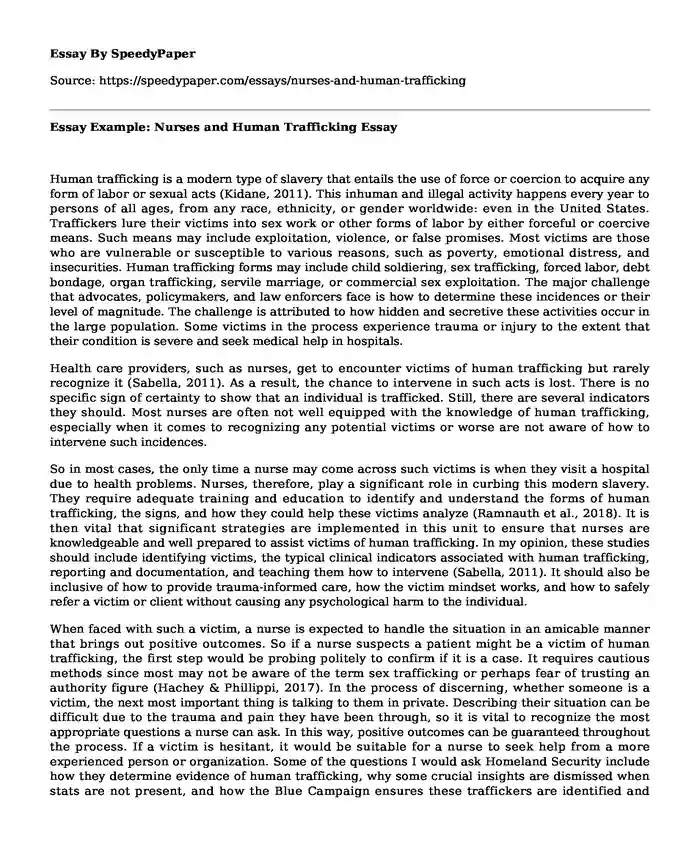
| Type of paper: | Essay |
| Categories: | Violence Nursing Sexual abuse Human trafficking |
| Pages: | 3 |
| Wordcount: | 697 words |
Human trafficking is a modern type of slavery that entails the use of force or coercion to acquire any form of labor or sexual acts (Kidane, 2011). This inhuman and illegal activity happens every year to persons of all ages, from any race, ethnicity, or gender worldwide: even in the United States. Traffickers lure their victims into sex work or other forms of labor by either forceful or coercive means. Such means may include exploitation, violence, or false promises. Most victims are those who are vulnerable or susceptible to various reasons, such as poverty, emotional distress, and insecurities. Human trafficking forms may include child soldiering, sex trafficking, forced labor, debt bondage, organ trafficking, servile marriage, or commercial sex exploitation. The major challenge that advocates, policymakers, and law enforcers face is how to determine these incidences or their level of magnitude. The challenge is attributed to how hidden and secretive these activities occur in the large population. Some victims in the process experience trauma or injury to the extent that their condition is severe and seek medical help in hospitals.
Health care providers, such as nurses, get to encounter victims of human trafficking but rarely recognize it (Sabella, 2011). As a result, the chance to intervene in such acts is lost. There is no specific sign of certainty to show that an individual is trafficked. Still, there are several indicators they should. Most nurses are often not well equipped with the knowledge of human trafficking, especially when it comes to recognizing any potential victims or worse are not aware of how to intervene such incidences.
So in most cases, the only time a nurse may come across such victims is when they visit a hospital due to health problems. Nurses, therefore, play a significant role in curbing this modern slavery. They require adequate training and education to identify and understand the forms of human trafficking, the signs, and how they could help these victims analyze (Ramnauth et al., 2018). It is then vital that significant strategies are implemented in this unit to ensure that nurses are knowledgeable and well prepared to assist victims of human trafficking. In my opinion, these studies should include identifying victims, the typical clinical indicators associated with human trafficking, reporting and documentation, and teaching them how to intervene (Sabella, 2011). It should also be inclusive of how to provide trauma-informed care, how the victim mindset works, and how to safely refer a victim or client without causing any psychological harm to the individual.
When faced with such a victim, a nurse is expected to handle the situation in an amicable manner that brings out positive outcomes. So if a nurse suspects a patient might be a victim of human trafficking, the first step would be probing politely to confirm if it is a case. It requires cautious methods since most may not be aware of the term sex trafficking or perhaps fear of trusting an authority figure (Hachey & Phillippi, 2017). In the process of discerning, whether someone is a victim, the next most important thing is talking to them in private. Describing their situation can be difficult due to the trauma and pain they have been through, so it is vital to recognize the most appropriate questions a nurse can ask. In this way, positive outcomes can be guaranteed throughout the process. If a victim is hesitant, it would be suitable for a nurse to seek help from a more experienced person or organization. Some of the questions I would ask Homeland Security include how they determine evidence of human trafficking, why some crucial insights are dismissed when stats are not present, and how the Blue Campaign ensures these traffickers are identified and brought to justice.
References
Hachey, L. M., & Phillippi, J. C. (2017). Identification and management of human trafficking victims in the emergency department. Advanced emergency nursing journal, 39(1), 31-51.
Kidane, W. (2011). Introduction: Understanding human trafficking and its victims. Seattle Journal for Social Justice, 9(2), 1.
Ramnauth, T., Benitez, M., Logan, B., Abraham, S. P., & Gillum, D. (2018). Nurses’ awareness of human trafficking. International Journal of Studies in Nursing, 3(2), 76.
Sabella, D. (2011). The role of the nurse in combating human trafficking. AJN. The American Journal of Nursing, 111(2), 28-37.
Cite this page
Essay Example: Nurses and Human Trafficking. (2023, Sep 10). Retrieved from https://speedypaper.net/essays/nurses-and-human-trafficking
Request Removal
If you are the original author of this essay and no longer wish to have it published on the SpeedyPaper website, please click below to request its removal:
- Essay Sample on Communication Barriers Between Nigerians and Chinese
- Free Essay on Charter of Human Rights and Responsibilities 2006
- Teachers Should Not Be Allowed to Carry Guns Essay for Students
- Free Essay Sample on International Public Relation Case Study
- Nursing Essay Sample on the Evidence-Based Project Related to End-of-Life Care
- Free Essay Example on the Injustice in The Workplace
- Paper Example: Perpetrators' Treatment in the Saving and Loans Scandal in Arkansas
Popular categories




